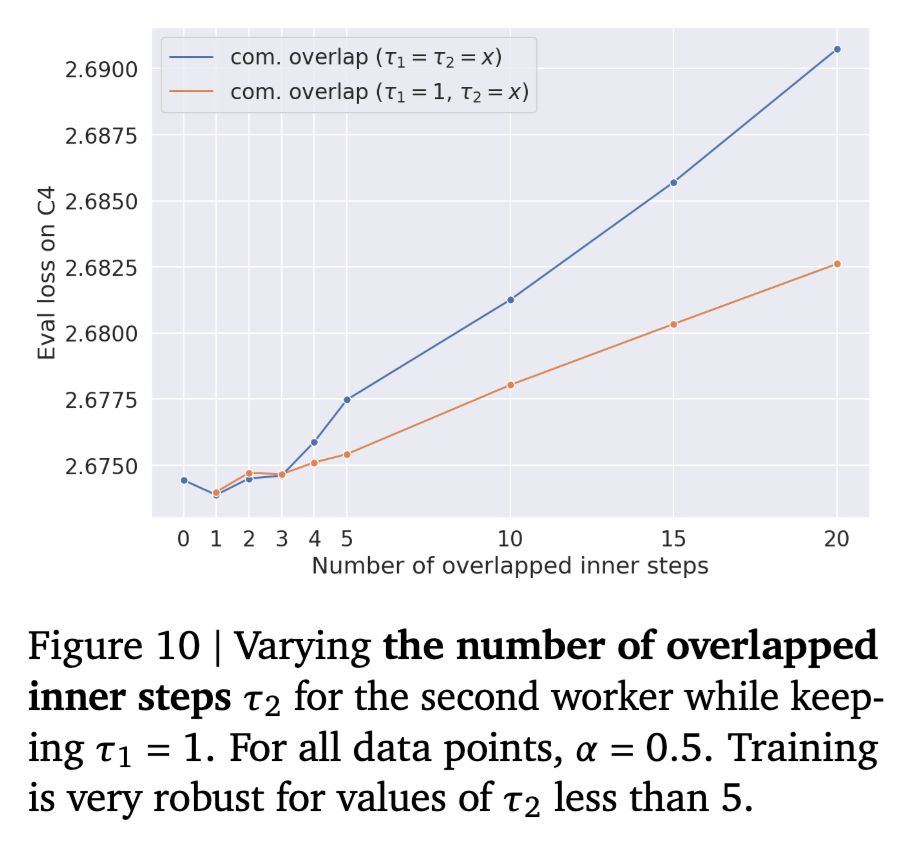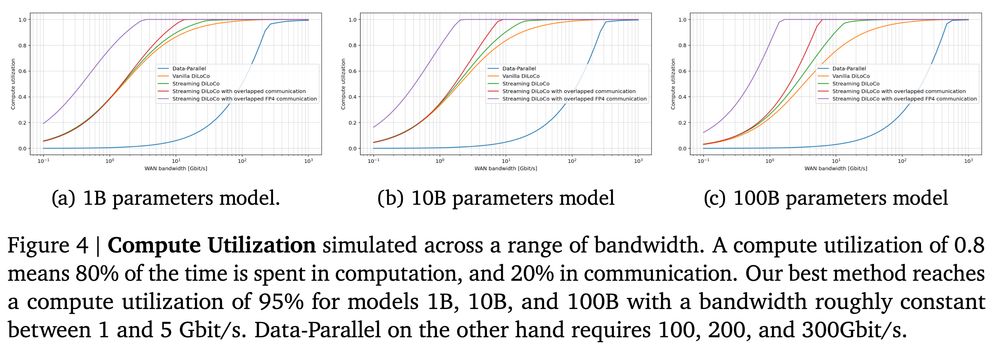@huggingface page: https://huggingface.co/papers/2502.12996
congrats to my collaborators @SatyenKale who led that work and Yani Donchev

@huggingface page: https://huggingface.co/papers/2502.12996
congrats to my collaborators @SatyenKale who led that work and Yani Donchev
DP requires 471 Gbits/s
Streaming DiLoCo with inner com. overlap: 1.4 Gbits/s
Streaming DiLoCo with eager outer com. overlap: 400Mbits/s, more than 1000x reduction
400Mbits/s is consumer-grade bandwidth FYI

DP requires 471 Gbits/s
Streaming DiLoCo with inner com. overlap: 1.4 Gbits/s
Streaming DiLoCo with eager outer com. overlap: 400Mbits/s, more than 1000x reduction
400Mbits/s is consumer-grade bandwidth FYI

the update is made of the average of the *local up-to-date* update of the self replica and the *remote stale* update from the other replicas

the update is made of the average of the *local up-to-date* update of the self replica and the *remote stale* update from the other replicas
we can recover a bit by lowering the outer learning by 4x, but this is still unsatisfying

we can recover a bit by lowering the outer learning by 4x, but this is still unsatisfying
we first try a naive "delayed" version

we first try a naive "delayed" version
we can safely overlap up to 5 steps, but more than that and performance drops rapidly!
https://x.com/Ar_Douillard/status/1885292127678021751
we can safely overlap up to 5 steps, but more than that and performance drops rapidly!
https://x.com/Ar_Douillard/status/1885292127678021751
however, when syncing, this is a blocking operation!
https://x.com/Ar_Douillard/status/1724732329740976187
however, when syncing, this is a blocking operation!
https://x.com/Ar_Douillard/status/1724732329740976187


We finished this last spring, and it was one of the coolest project i've been on.
The future will be distributed 🫡
https://arxiv.org/abs/2501.18512v1
We finished this last spring, and it was one of the coolest project i've been on.
The future will be distributed 🫡
https://arxiv.org/abs/2501.18512v1
So so many ideas we try just work on top of DiLoCo. And it can scale too! Look at the cracked folks of @PrimeIntellect who scaled their version to 10B
So so many ideas we try just work on top of DiLoCo. And it can scale too! Look at the cracked folks of @PrimeIntellect who scaled their version to 10B
Can we break away from the lockstep synchronization? yes!
Workers can have a few delay steps, and it just work, w/o any special handling.

Can we break away from the lockstep synchronization? yes!
Workers can have a few delay steps, and it just work, w/o any special handling.
Over how many steps can you overlap safely communication?
At least 5 without any significant loss of perf! That's a massive increase of tolerated latency.

Over how many steps can you overlap safely communication?
At least 5 without any significant loss of perf! That's a massive increase of tolerated latency.

It has only 35B activated params, but you need to sync 671B params in total! Hard to do across continents with data-parallel...
However, with our method? ❤️🔥

It has only 35B activated params, but you need to sync 671B params in total! Hard to do across continents with data-parallel...
However, with our method? ❤️🔥
but we need to scale more our pretraining, this is still a relevant axis!
DeepSeek-R1 also notes it:

but we need to scale more our pretraining, this is still a relevant axis!
DeepSeek-R1 also notes it:
Abolish the tyranny of requiring huge bandwidth! ✊

Abolish the tyranny of requiring huge bandwidth! ✊
As @m_ryabinin noted in Swarm Parallelism: larger networks spent more time doing computation O(n^3) vs doing communication O(n^2).
We have much more time to sync at larger scales!

As @m_ryabinin noted in Swarm Parallelism: larger networks spent more time doing computation O(n^3) vs doing communication O(n^2).
We have much more time to sync at larger scales!
It estimates how much time is spent in the costly com. between non-colocated devices and how much is spent crunching flops.

It estimates how much time is spent in the costly com. between non-colocated devices and how much is spent crunching flops.
It's even better when overtraining with a larger token budget? remember the bitter lesson? just put more data and flops in your model, Streaming DiLoCo enables that.

It's even better when overtraining with a larger token budget? remember the bitter lesson? just put more data and flops in your model, Streaming DiLoCo enables that.
Quantize your update with 4 bits is enough -- you can barely see any changes on the performance.
And that's the free dessert 🍦

Quantize your update with 4 bits is enough -- you can barely see any changes on the performance.
And that's the free dessert 🍦

